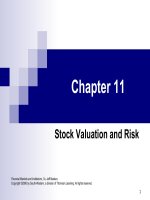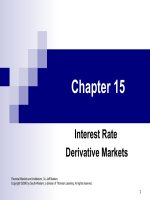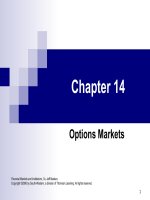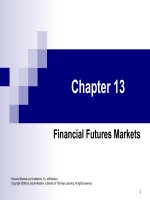Thị trường tài chính và các định chế tài chính_ Chapter 11
Bạn đang xem bản rút gọn của tài liệu. Xem và tải ngay bản đầy đủ của tài liệu tại đây (179.98 KB, 54 trang )
1
Chapter 11
Stock Valuation and Risk
Financial Markets and Institutions, 7e, Jeff Madura
Copyright ©2006 by South-Western, a division of Thomson Learning. All rights reserved.
2
Chapter Outline
Stock valuation methods
Determining the required rate of return to value stocks
Factors that affect stock prices
Role of analysts in valuing stocks
Stock risk
Applying value at risk
Forecasting stock price volatility and beta
Stock performance measurement
Stock market efficiency
Foreign stock valuation, performance, and efficiency
3
Stock Valuation Methods
The price-earnings (PE) method assigns the
mean PE ratio based on expected earnings of
all traded competitors to the firm’s expected
earnings for the next year
Assumes future earnings are an important
determinant of a firm’s value
Assumes that the growth in earnings in future years
will be similar to that of the industry
4
Stock Valuation Methods (cont’d)
Price-earnings (PE) method (cont’d)
Reasons for different valuations
Investors may use different forecasts for the firm’s earnings
or the mean industry earnings
Investors disagree on the proper measure of earnings
Limitations of the PE method
May result in inaccurate valuation for a firm if errors are
made in forecasting future earnings or in choosing the
industry composite
Some question whether an investor should trust a PE ratio
5
Valuing A Stock Using the PE
Method
A firm is expected to generate earnings of $2 per
share next year. The mean ratio of share price
to expected earnings of competitors in the
same industry is 14. What is the valuation of
the firm’s shares according to the PE method?
$2814$2
ratio) PEindustry (Meanshare) per firm of earnings Expected(share per Valuation
=×=
×=
6
Stock Valuation Methods (cont’d)
Dividend discount model
John Williams (1931) stated that the price of a stock
should reflect the present value of the stock’s future
dividends:
D can be revised in response to uncertainty about the firm’s
cash flows
k can be revised in response to changes in the required rate
of return by investors
∑
∞
=
+
=
1
)1(
Price
t
t
t
k
D
k
7
Stock Valuation Methods (cont’d)
Dividend discount model (cont’d)
For a constant dividend, the cash flow is a
perpetuity:
For a constantly growing dividend, the cash flow is
a growing perpetuity:
k
D
k
D
t
t
t
=
+
=
∑
∞
=1
)1(
Price
gk
D
k
D
t
t
t
−
=
+
=
∑
∞
=
1
1
)1(
Price
8
Valuing A Stock Using the
Dividend Discount Model
Example 1: A firm is expected to pay a dividend
of $2.10 per share every year in the
foreseeable future. Investors require a return
of 15% on the firm’s stock. According to the
dividend discount model, what is a fair price
for the firm’s stock?
14$
%15
10.2$
)1(
Price
1
===
+
=
∑
∞
=
k
D
k
D
t
t
t
9
Valuing A Stock Using the
Dividend Discount Model
Example 2: A firm is expected to pay a dividend
of $2.10 per share in one year. In every
subsequent year, the dividend is expected to
grow by 3 percent annually. Investors
require a return of 15% on the firm’s stock.
According to the dividend discount model,
what is a fair price for the firm’s stock?
50.17$
%3%15
10.2$
)1(
Price
1
1
=
−
=
−
=
+
=
∑
∞
=
gk
D
k
D
t
t
t
10
Stock Valuation Methods (cont’d)
Dividend discount model (cont’d)
Relationship between dividend discount model
and PE ratio
The PE multiple is influenced by the required rate of
return and the expected growth rate of competitors
The inverse relationship between required rate of return
and value exists in both models
The positive relationship between a firm’s growth rate
and its value exists in both models
11
Stock Valuation Methods (cont’d)
Dividend discount model (cont’d)
Limitations of the dividend discount model
Errors can be made in determining the:
Dividend to be paid
Growth rate
Required rate of return
Errors are more pronounced for firms that retain most of
their earnings
12
Stock Valuation Methods (cont’d)
Adjusting the dividend discount model
The value of the stock is:
The PV of the future dividends over the investment
horizon
The PV of the forecasted price at which the stock will be
sold
Must estimate the firm’s EPS in the year they plan to sell
the stock by applying an annual growth rate to the
prevailing EPS
13
Using the Adjusted Dividend
Discount Model
Parker Corp. currently has earnings of $10 per
share. Investors expect that the EPS will
growth by 3 percent per year and expect to
sell the stock in four years. What is the EPS
in four years?
26.11$)03.1(10$
)1( yearsn in earnings Forecasted
4
=×=
+=
n
GE
14
Using the Adjusted Dividend
Discount Model (cont’d)
Other firms in Parker’s industry have a mean PE
ratio of 7. What is the estimated stock price in
four years?
82.78$726.11$
industry) of ratio (PE years)4 in Earnings( years4 in price Stock
=×=
×=
15
Using the Adjusted Dividend
Discount Model (cont’d)
Parker is expected to pay a dividend of $2 per
share over the next four years. Investors
require a return of 13% on their investment.
Based on this information, what is a fair value
of the stock according to the adjusted
dividend discount model?
29.54$
)13.1(
82.78$
)13.1(
2$
)13.1(
2$
)13.1(
2$
)13.1(
2$
44321
=
++++=PV
16
Stock Valuation Methods (cont’d)
Adjusting the dividend discount model
(cont’d)
Limitations of the adjusted dividend discount
model
Errors can be made in deriving the PV of dividends over
the investment horizon or the forecasted price at which
the stock can be sold
Errors can be made if an improper required rate of return
is used
17
Determining the Required Rate of
Return to Value Stocks
The capital asset pricing model:
Assumes that the only important risk is systematic
risk
Is not concerned with unsystematic risk
Suggests that the return on an asset is influenced by
the prevailing risk-free rate, the market return, and
the covariance between a stock’s return and the
market’s return:
)(
fmjfj
RRBRR −+=
18
Determining the Required Rate of
Return to Value Stocks (cont’d)
The capital asset pricing model (cont’d)
Estimating the risk-free rate and the market risk premium
The yield on newly issued T-bonds is commonly used as a proxy
for the risk-free rate
The terms within the parentheses measure the market risk
premium
Historical data over 30 or more years can be used to determine
the average market risk premium over time
Estimating the firm’s beta
Beta reflects the sensitivity of the stock’s return to the market’s
overall return
Beta is typically measured with monthly or quarterly data over the
last four years or so
19
Using the CAPM
Fantasia Corp. has a beta of 1.7. The prevailing
risk-free rate is 5% and the market risk
premium is 5%. What is the required rate of
return of Fantasia Corp. according to the
CAPM?
%5.13
%)5%10(7.1%5
)(
=
−+=
−+=
fmjfj
RRBRR
20
Determining the Required Rate of
Return to Value Stocks (cont’d)
The capital asset pricing model (cont’d)
Limitations of the CAPM
A study by Fama and French found that beta is unrelated to
the return on stock over the 1963–1990 period
Chan and Lakonishok:
Found that the relation between stock returns and beta
varied with the time period used
Concluded that it is appropriate to question whether beta is
the driving force behind stock returns
Found that firms with the highest betas performed much
worse than firms with low betas
Found that high-beta firms outperformed low-beta firms
during market upswings
21
Determining the Required Rate of
Return to Value Stocks (cont’d)
Arbitrage pricing model
Suggests that a stock’s price can be influenced by a
set of factors in addition to the market
e.g., economic growth, inflation
In equilibrium, expected returns on assets are linearly
related to the covariance between assets returns and
the factors:
∑
=
+=
m
i
ii
FBBRE
1
0
)(
22
Factors That Affect Stock Prices
Economic factors
Impact of economic growth
An increase in economic growth increases expected cash
flows and value
Indicators such as employment, GDP, retail sales, and
personal income are monitored by market participants
Impact of interest rates
Given a choice of risk-free Treasury securities or stocks,
stocks should only be purchased if they offer a sufficiently
high expected return
23
Factors That Affect Stock Prices
(cont’d)
Economic factors (cont’d)
Impact of the dollar’s exchange rate value
The value of the dollar affects U.S. stocks because:
Foreign investors purchase U.S. stocks when the dollar is
weak
Stock prices are affected by the impact of the dollar’s
changing value on cash flows
Some U.S. firms are involved in exporting
U.S.-based MNCs have some earnings in foreign currencies
Exchange rates may affect expectations of other economic
factors
24
Factors That Affect Stock Prices
(cont’d)
Market-related factors
Investor sentiment
In some periods, stock market performance is not highly
correlated with existing economic conditions
Stocks can exhibit excessive volatility because their prices are
partially driven by fads and fashions
A study by Roll found that only one-third of the variation in stocks
returns can be explained by systematic economic forces
January effect
Many portfolio managers invest in riskier small stocks at the
beginning of the year and shift to larger companies near the end
of the year
Places upward pressure on small stocks in January
25
Factors That Affect Stock Prices
(cont’d)
Firm-specific factors
Some firms are more exposed to conditions within their own
industry than to general economic conditions, so participants
monitor:
Industry sales forecasts
Entry into the industry by new competitors
Price movements of the industry’s products
Market participants focus on announcements that signal
information about a firm’s sales growth, earnings, or
characteristics that cause a revision in the expected cash flows









